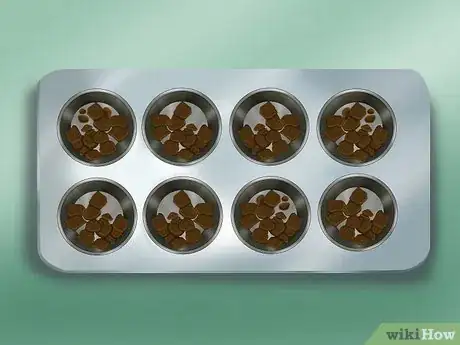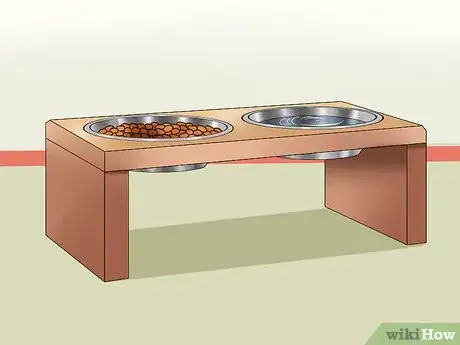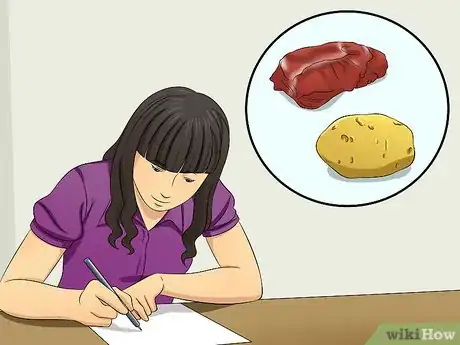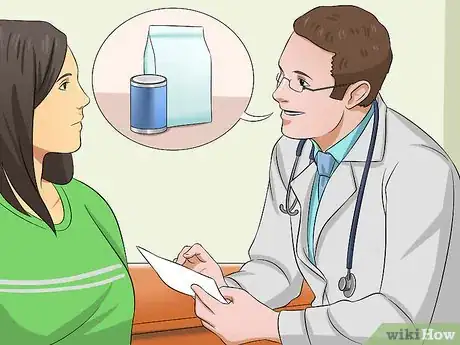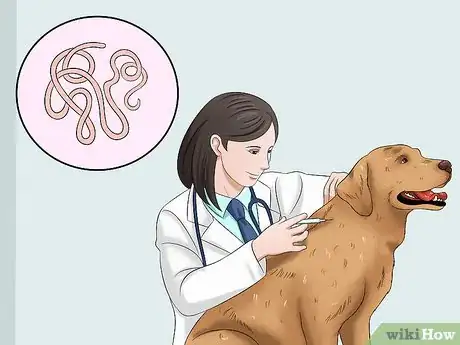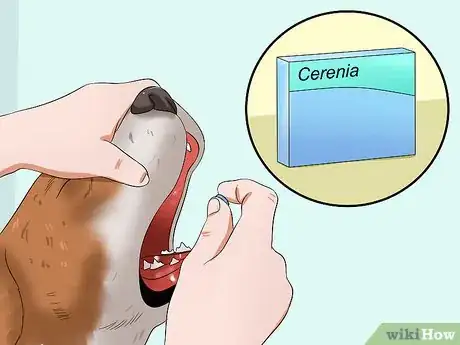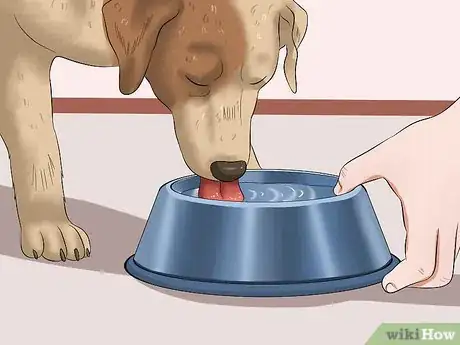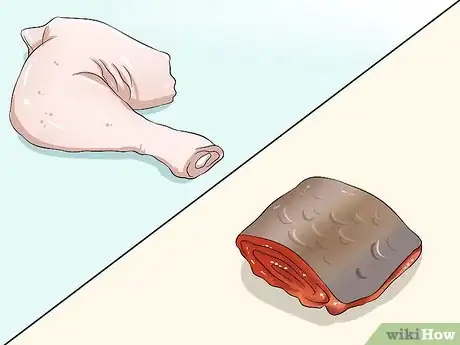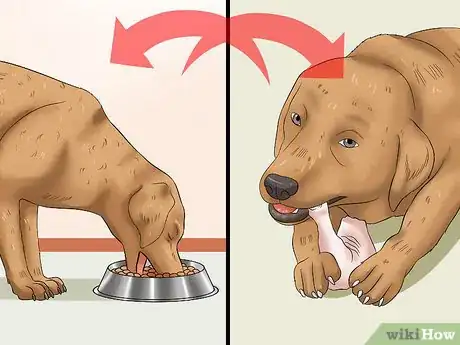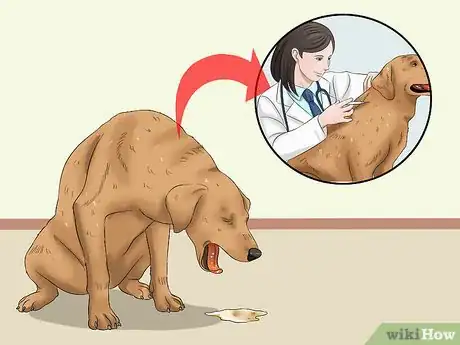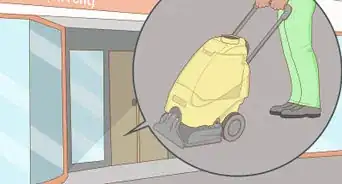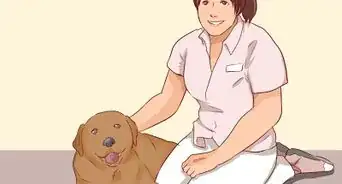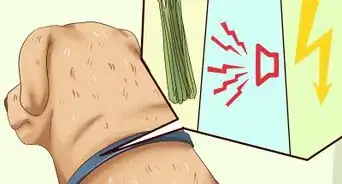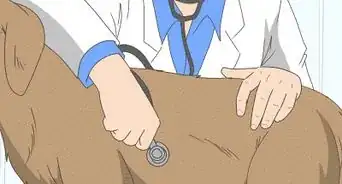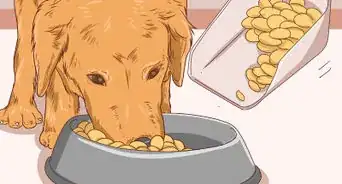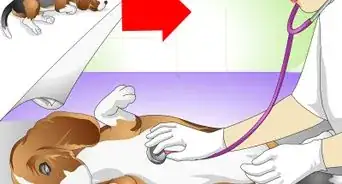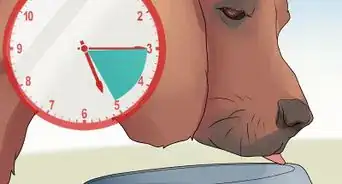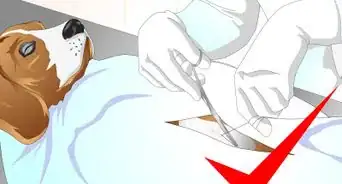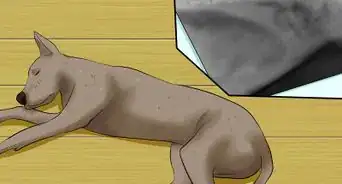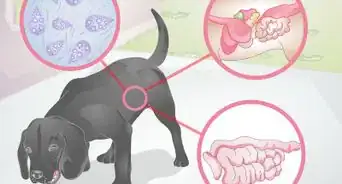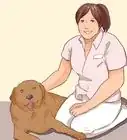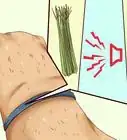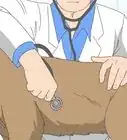This article was co-authored by Ray Spragley, DVM. Dr. Ray Spragley is a Doctor of Veterinary Medicine and the Owner/Founder of Zen Dog Veterinary Care PLLC in New York. With experience in multiple institutions and private practices, Dr. Spragley’s specializations and interests include non-surgical management of cranial cruciate ligament tears, Intervertebral Disk Disease(IVDD), and pain management in osteoarthritis. Dr. Spragley holds a BS in Biology from SUNY Albany and has a Doctor of Veterinary Medicine degree (DVM) from Ross University School of Veterinary Medicine. He is also a Certified Canine Rehabilitation Therapist (CCRT) through the Canine Rehab Institute as well as a Certified Veterinary Acupuncturist (CVA) through Chi University.
There are 8 references cited in this article, which can be found at the bottom of the page.
This article has been viewed 129,378 times.
Dogs occasionally vomit, especially if they've been scavenging and eating food. Dogs will naturally throw up food that would otherwise cause food poisoning. If your dog vomits but is otherwise well, keep a close eye on what your dog is eating or drinking. If your dog is vomiting, but showing other health problems, take your dog to the veterinarian and treat any underlying health issues.
Steps
Preventing Frequent Vomiting
-
1Slow down a fast eater. Many dogs gulp their food down way too fast, which means they swallow air with the food. This then causes the dog to be sick later.
- Strategies for slowing a greedy eater include putting their food in a muffin tray, putting large rocks (too large to swallow) in the food bowl, or purchasing a commercially available slow feeder platter.
-
2Raise the food bowl off the floor. Place it on a low wall, chair, or table, so that the bowl is above the dog's shoulder height. When your dog has to raise his front end off the ground to eat, gravity will help the food pass down his gullet down into his stomach.[1]
- Try keeping him in the raised position for 10 minutes after he's emptied the bowl. This works best if the dog has a condition called megaesophagus in which the dog has weak contractions in the gullet so food takes a long time to pass down into the stomach.
Advertisement -
3Consider a change of diet. Review your dog's food intake for the past month and work out what types of meat he has eaten. Then, select a meat he has never eaten before (such as venison) and feed him a diet of just that meat and one carbohydrate source (for example, potato).[2]
- Some dogs have food sensitivities or intolerances. The allergen is most commonly a protein source (a meat such as lamb, beef, or fish), but can include gluten or even rice. The allergen causes your dog to release inflammatory cells, which causes him to vomit.[3]
-
4Ask your vet to prescribe a diet. Alternatively, your vet can advise you about prescription hypoallergenic diets where the hard work of preparation has been done for you. Feed this diet and nothing else, and don't expect to see results for about 2 weeks. It can take that long for the inflammation to settle down.[4]
- Examples of these diets include the Hills DD range, HiIls ZD and ZD ultra, and Purina HA.
-
5Get your dog dewormed. Worms can sometimes irritate the stomach lining, making the dog more likely to throw up. Regularly have your dog dewormed by the vet, preferably every three months.[5]
- Consider having your dog dewormed more often if he regularly scavenges or hunts.
-
6Treat your dog for motion sickness. Some dogs suffer from motion sickness when they go on car journeys. Make sure the car is well-ventilated and not overly stuffy. It may help if a small dog can see out of a window, in which case, purchase a dog booster seat to raise him up (always wear a safety harness when traveling in the car).
- For long journeys, your vet can prescribe Cerenia (maropitant) which is a highly effective, non-drowsy medication that prevents motion sickness. It won't make your dog drowsy, so he'll be alert for the day. The dose of maropitant is 2 mg/ kg by mouth, once every 24 hours for up to 5 days.[6]
-
7Determine if you should take your dog to the veterinarian. If his feces are normal, he is not losing weight, he has plenty of energy and his coat is glossy, but he is throwing up several times a week, considering seeing a vet.[7] In addition, make some observations which can help the vet. Take some photos of the vomit (this can help the vet decide if this is true vomiting, or if the dog is regurgitating food.)[8]
- You can also keep a simple diary of how often he is sick, how long after eating it happens, and what the dog is fed. This can help you to spot any patterns that emerge. For instance, did the sickness start not long after you changed his brand of dog food? Did the sickness start right after his favorite toy went missing?
Caring For Your Dog After It's Vomited
-
1Don't feed your dog for 24 hours. He may still be feeling nauseous and chances are that any food he eats may be vomited back. The repeated contraction of the stomach muscles when the dog vomits can cause inflammation of the stomach lining. This will make him more likely to vomit again, creating a vicious cycle.[9]
- Avoiding food for the day allows the nausea to disperse and stops the cycle of vomiting. Do however, allow the dog access to drinking water. If he drinks and vomits, seek veterinary attention.
-
2Supervise water drinking. Allow him to drink small amounts of water regularly (like humans sipping water when sick). For a small dog, say under 10 kg, offer an egg cup full of water every half an hour. If he drinks this without vomiting, then after two hours you can allow him free, unrestricted access to water. If he vomits even this small amount back then seek veterinary attention. (A larger dog, say a Labrador size, is allowed half a cup of water every half an hour).[10]
- If the has vomited recently, he may wish to get the nasty taste out of his mouth. However, if he goes to a large water bowl and drains the entire volume of water, that water will hit his sensitive stomach and he's likely to vomit the water back up.
-
3Introduce bland food. When the 24 hours of no food is up, give your dog a small meal of bland food. This should only be a fraction of his usual amount, to see if he eats and test out if the food stays down.[11] As a general rule bland foods are low fat, white meat such as chicken, turkey, rabbit, cod, or coley and an easy to digest carbohydrate such as white rice, pasta, or boiled mashed potato (without the addition of dairy products).[12]
- Avoid high fat foods such as dairy produce, oily fish, or rich protein sources such as red meat. Your veterinarian can also supply ready-made diets that are proven to speed recovery time from stomach upsets. These include Hills ID, and Purina EN.
-
4Transition back to your dog's normal diet. If everything goes well and your dog doesn't throw up again after 24 hours of bland food, transition him back to his regular diet. Avoid sudden changes of food, so mix ⅓ of his regular food with ⅔ bland diet on day 1, then half on day 2, then ⅔ regular and ⅓ bland on day 3, and day 4 entirely back onto his regular food.[13]
- It is best to feed little and often, so as not to overload his stomach. Try dividing his daily food allowance into four portions and space those four meals out over the day: breakfast, lunch, tea, and supper.
-
5Watch for signs that you should take your dog to the veterinarian.[14] Throwing up can be a general sign of ill health, and should not be ignored if your dog vomits regularly. A dog that cannot keep fluids down may become dehydrated which is dangerous in itself and requires medical attention. Here are some signs that your dog should get medical attention:[15]
- Not keeping fluids down: If the dog drinks water but is unable to keep it down, and this persists for more than one to two hours.
- If the dog has other problems such as diarrhea (which means he is losing fluid from his back end as well as through vomiting)
- Persistent vomiting for more than four hours
- Blood in the vomit
- The dog is on medication such as a painkiller from the NSAID group (such as Metacam, Onsior, or Rimadyl)
- The dog is dehydrated - lift his scruff and let it go. If it takes over 1 - 2 seconds to flatten back down, the dog is dehydrated.
- The dog has other health problems such as kidney disease or diabetes.
- Lacking in energy or listless.
- The dog vomits regularly (daily) and is losing weight.
Expert Q&A
-
QuestionWhat do you give a dog with an upset stomach?
 Ray Spragley, DVMDr. Ray Spragley is a Doctor of Veterinary Medicine and the Owner/Founder of Zen Dog Veterinary Care PLLC in New York. With experience in multiple institutions and private practices, Dr. Spragley’s specializations and interests include non-surgical management of cranial cruciate ligament tears, Intervertebral Disk Disease(IVDD), and pain management in osteoarthritis. Dr. Spragley holds a BS in Biology from SUNY Albany and has a Doctor of Veterinary Medicine degree (DVM) from Ross University School of Veterinary Medicine. He is also a Certified Canine Rehabilitation Therapist (CCRT) through the Canine Rehab Institute as well as a Certified Veterinary Acupuncturist (CVA) through Chi University.
Ray Spragley, DVMDr. Ray Spragley is a Doctor of Veterinary Medicine and the Owner/Founder of Zen Dog Veterinary Care PLLC in New York. With experience in multiple institutions and private practices, Dr. Spragley’s specializations and interests include non-surgical management of cranial cruciate ligament tears, Intervertebral Disk Disease(IVDD), and pain management in osteoarthritis. Dr. Spragley holds a BS in Biology from SUNY Albany and has a Doctor of Veterinary Medicine degree (DVM) from Ross University School of Veterinary Medicine. He is also a Certified Canine Rehabilitation Therapist (CCRT) through the Canine Rehab Institute as well as a Certified Veterinary Acupuncturist (CVA) through Chi University.
Veterinarian If your dog is showing signs of gastrointestinal upset you can try to feed a bland diet for a few days. Chicken and rice is ideal because it is low in fat. Do not give rich fatty foods which can worsen the stomach issues. If your dog continues to not eat or begins having signs such as vomiting, diarrhoea, lethargy, or straining to defecate they should be examined by your veterinarian immediately.
If your dog is showing signs of gastrointestinal upset you can try to feed a bland diet for a few days. Chicken and rice is ideal because it is low in fat. Do not give rich fatty foods which can worsen the stomach issues. If your dog continues to not eat or begins having signs such as vomiting, diarrhoea, lethargy, or straining to defecate they should be examined by your veterinarian immediately. -
QuestionWhat should I do if the dog has blood in his vomit?
 Pippa Elliott, MRCVSDr. Elliott, BVMS, MRCVS is a veterinarian with over 30 years of experience in veterinary surgery and companion animal practice. She graduated from the University of Glasgow in 1987 with a degree in veterinary medicine and surgery. She has worked at the same animal clinic in her hometown for over 20 years.
Pippa Elliott, MRCVSDr. Elliott, BVMS, MRCVS is a veterinarian with over 30 years of experience in veterinary surgery and companion animal practice. She graduated from the University of Glasgow in 1987 with a degree in veterinary medicine and surgery. She has worked at the same animal clinic in her hometown for over 20 years.
Veterinarian Blood in the vomit is an important sign and shouldn't be ignored. The reasons range widely from irritation of the stomach lining due to repeated sickness, through to gastric ulcers, cancer, or clotting problems. It is best to get the dog seen by a vet.
Blood in the vomit is an important sign and shouldn't be ignored. The reasons range widely from irritation of the stomach lining due to repeated sickness, through to gastric ulcers, cancer, or clotting problems. It is best to get the dog seen by a vet. -
QuestionMy dog throws up about half an hour after eating. The food is whole, as if she hasn't chewed it. What should I do?
 Pippa Elliott, MRCVSDr. Elliott, BVMS, MRCVS is a veterinarian with over 30 years of experience in veterinary surgery and companion animal practice. She graduated from the University of Glasgow in 1987 with a degree in veterinary medicine and surgery. She has worked at the same animal clinic in her hometown for over 20 years.
Pippa Elliott, MRCVSDr. Elliott, BVMS, MRCVS is a veterinarian with over 30 years of experience in veterinary surgery and companion animal practice. She graduated from the University of Glasgow in 1987 with a degree in veterinary medicine and surgery. She has worked at the same animal clinic in her hometown for over 20 years.
Veterinarian If the food is not chewed then it may be she eats too quickly and swallows a lot of air. This can then make her sick as short while later. Try and slow her eating. There are lots of way to do this, from putting large rocks in her bowl to dividing up her meal in a muffin tray to store-bought slow feeders. If, however, she seems ill, is losing weight, thirsty, or not herself, then a vet check is essential.
If the food is not chewed then it may be she eats too quickly and swallows a lot of air. This can then make her sick as short while later. Try and slow her eating. There are lots of way to do this, from putting large rocks in her bowl to dividing up her meal in a muffin tray to store-bought slow feeders. If, however, she seems ill, is losing weight, thirsty, or not herself, then a vet check is essential.
Warnings
- Anytime the wellness of your pet diminishes and continues for more than a few days, contact your veterinarian.⧼thumbs_response⧽
References
- ↑ Canine and Feline Megaesophagus. Mears & Jenkins. Comp Cont Ed Prac Vet 19
- ↑ Adverse reactions to food: a gastrointestinal perspective. Guilford. Comp Cont Ed Prac Vet 16
- ↑ Small Animal Internal Medicine. Nelson & Couto. Publisher: Mosby
- ↑ Adverse reactions to food: a gastrointestinal perspective. Guilford. Comp Cont Ed Prac Vet 16
- ↑ http://www.veterinarypartner.com/Content.plx?A=476
- ↑ Plumb's Veterinary Drug Handbook. Donald Plumb. Publisher: Wiley-Blackwell
- ↑ Ray Spragley, DVM. Veterinarian. Expert Interview. 5 March 2021.
- ↑ https://www.aspca.org/pet-care/dog-care/vomiting
- ↑ http://www.petmd.com/dog/emergency/common-emergencies/e_dg_vomiting
- ↑ http://www.petmd.com/dog/emergency/common-emergencies/e_dg_vomiting
- ↑ Ray Spragley, DVM. Veterinarian. Expert Interview. 5 March 2021.
- ↑ http://www.petmd.com/dog/emergency/common-emergencies/e_dg_vomiting
- ↑ http://www.petmd.com/dog/emergency/common-emergencies/e_dg_vomiting
- ↑ Ray Spragley, DVM. Veterinarian. Expert Interview. 5 March 2021.
- ↑ https://www.aspca.org/pet-care/dog-care/vomiting
About This Article
To keep a dog from throwing up, raise its food bowl to shoulder-level, so that gravity can help the food pass into your dog’s stomach. Alternatively, try slowing down how fast it eats down by putting its food in a muffin tray or a slow feeder plate made specially for dogs. You should also consider changing to a food without possible allergens, like gluten or lamb. If your dog is still throwing up its food, take it to the vet for deworming every 3 months, since worms may be irritating its stomach lining. For advice from our Veterinary co-author on how to care for your dog after it throws up, read on!
